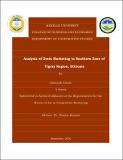| dc.description.abstract | An efficient agricultural marketing is crucial for effective agricultural and rural development,
particularly with regard to sustained increase in agricultural production, and farmer’s income.
The market for grain is the largest of all markets in Ethiopia in terms of the volume of output
handled, the number of market participants involved, and the vastness of the geographical area
of operation. This study examined grain marketing in Ofla and Endamohoni wereda with the
specific objectives of identifying marketing channels, organizational structure and coordination
of the grain markets, and identifying factors affecting grain supply in the weredas. A total of 145
head of households were selected randomly using probability proportional to sample size (PPS).
Data from 24 traders was also collected from the two markets. This particular study revealed
that 41% of the total grain production in the sample area was supplied to the market. According
to the results of the study in 2009/10, 30% and 23% of farmers’ production was purchased by
cooperative unions and directly by consumers, respectively. The measures of market
concentration indicated that the grain market structure in the study area is fairly competitive;
however the existence of barriers to entry, and the constraints facing traders have a negative
impact on the performance of the grain marketing system. The major barriers to entry in to grain
trade in the study areas included lack of working capital, market information and high
competition with the cooperative unions and unlicensed traders. The major determinant factors
affecting market participation decision and quantity of grain supply were estimated by Tobit and
Heckman two stage econometric models. Among the variables included in the analysis, 5
variables such as nonfarm income, total livestock unit, oxen number, market information and
yield influence the quantity of grain supply positively significantly and family size affected
negatively the supply of grain at 5% significant. Transport cost was identified as the major cost
component of marketing costs which accounted 44.19% and 45.13%, for wholesalers and
assemblers respectively. The main grain marketing constraints for traders are shortage of
capital, shortage of supply, lack of timely and accurate market information, poor access to credit
and competition with unlicensed traders were few of the inherent problems. The possible
recommendations forwarded are support formal access to credit for traders and farmers,
strengthen access to market information encourage licensing of traders, intervention to increase
production by using improved agricultural inputs, strengthen cooperatives and their unions and
conduct a research on the different components of the marketing system. | en_GB |


